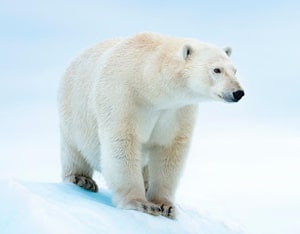English Documentary on Polar Bears with Transcript, podcast and illustrated flashcards to improve your listening and reading comprehension and expand your vocabulary
Source of documentary: National Geographic YouTube Channel
Polar bears are not white
Polar bears’ fur is not white. The fur is actually transparent; It consists of two layers of transparent hair: a soft, thick undercoat, and a layer of hallow guard hair. The layers only appear white because the air spaces in each hair scatter all visible wavelengths of light.
Underneath this fur, polar bears have black skin. Sunlight can penetrate the bear’s transparent fur and reach its black skin, which absorbs the sun’s heat and warms the bear’s body.
Strong swimmers
Polar bears are excellent swimmers. They’ve evolved to have a narrow skull and a long, flexible neck, which are believed to help streamline their bodies in the water and provide the reach and the flexibility they need to bring their noses up for air.
Their front paws are large, up to 12 inches wide, flat and act as paddles as the bears swim, and even hunt marine animals while underwater. Additionally, the bears have a two to four inch layer of fat that helps keep them buoyant and warm, as they swim.
Cute but humongous
Polar bears are the largest land carnivore. They may grow up to eight feet tall and weigh up to 1760 pounds, far outweighing the next largest land predator, the Kodiak brown bear, by several hundreds of pounds. This hefty size allows polar bears to hunt large powerful animals like walruses and beluga whales. Because of their tremendous size, polar bears have no natural predators, apart from humans.
Polar bear’s habitat
Polar bears only live in the Arctic. This region includes areas of Russia, Greenland, Norway and the United States. However, up to 80% of the world’s polar bears live in one country: Canada. Polar bears may traverse islands and coastlines, but most of the time, the bears live directly on sea ice that can be found between land masses. However, as climate change is causing sea ice to recede, polar bears are beginning to make their way further inland to find food.
Not endangered yet
Polar bears are not endangered for now. Between 22,000 and 31,000 polar bears are in the wild, but their populations may be at risk in the future. Climate change and rising ocean temperatures are causing sea ice, the polar bear’s hunting grounds, to melt more rapidly and for longer periods of time. This may play a role in a projected 30% population decrease by 2050.
Life on top of the world comes with many challenges, but with translucent fur, strong swimming capabilities and considerable body size, polar bears have become well adapted to life in the wintry North.




Polar bears are really cute but they have a bad life and they are in endangered. The ice caps In south pole and north pole is melting and this is so bad for polar bears.
Feedback
1. they are in endangered = they are in danger / they are endangered (animals)
2. south pole and north pole = the South Pole and the North Pole
It’s interesting that polar bears actually have black skin underneath their white fur. I’d love to hug one, but I’m not sure if they would appreciate it! It’s a relief that they’re not endangered; I would be so sad.
They’re not endangered yet, but polar bears are classified as vulnerable creatures.
This documantry contained so many new informations about polar bears for me. It’s always good to know more about other creatures and animals and their abilities and characteristics.
I was also fascinated by the new information about polar bears that I didn’t know before reading the transcript of this documentary.
—
Feedback
1. so many new informations = so much new information (Information is uncountable.)
Polar bears are not white
Polar bears’ fur is not white. The fur is actually transparent; It consists of two layers of transparent hair: a soft, thick undercoat and a layer of hallow guard hair. The layers only appear white because the air spaces in each hair, scatter all visible wavelengths of light. Underneath this fur, polar bears have black skin. Sunlight can penetrate the bear’s transparent fur and reach its black skin, which absorbs the sun’s heat and warms the bear’s body.
Strong swimmers
Polar bears are excellent swimmers. They’ve evolved to have a narrow skull and a long, flexible neck, which are believed to help streamline their bodies in the water and provide the reach and the flexibility they need, to bring their noses up for air. Their front paws are large, up to 12 inches wide, flat and act as paddles as the bears swim, and even hunt marine animals while underwater. Additionally, the bears have a 2-to-4-inch layer of fat that help keep them buoyant and warm, as they swim.
Cute but humongous
Polar bears are the largest land carnivore. They may grow up to eight feet tall and weigh up to 1760 pounds, far outweighing the next largest land predator, the Kodiak brown bear, by several hundreds of pounds. This hefty size allows polar bears to hunt large powerful animals like walruses and beluga whales. Because of their tremendous size, polar bears have no natural predators, apart from humans.
Polar bear habitat
Polar bears only live in the Arctic. This region includes areas of Russia, Greenland, Norway and the United States. However, up to 80% of the world’s polar bears live in one country: Canada. Polar bears may traverse islands and coastlines, but most of the time, the bears live directly on sea ice that can be found between land masses. However, as climate change is causing sea ice to recede, polar bears are beginning to make their way further inland to find food.
Not endangered yet
Polar bears are not endangered for now. Between 22,000 and 31,000 polar bears are in the wild, but their populations may be at risk in the future. Climate change and rising ocean temperatures are causing sea ice, the polar bear’s hunting grounds, to melt more rapidly and for longer periods of time. This may play a role in a projected 30% population decrease by 2050.
Life on top of the world comes with many challenges, but with translucent fur, strong swimming capabilities and considerable body size, polar bears have become well adapted to life in the wintry North.
Thank you so much for your transcription.
The only minor error I could detect is listed as below:
In the paragraph under the heading of “Strong swimmers”, the verb “help” changes to “helps” as its subject is “layer of fat”.